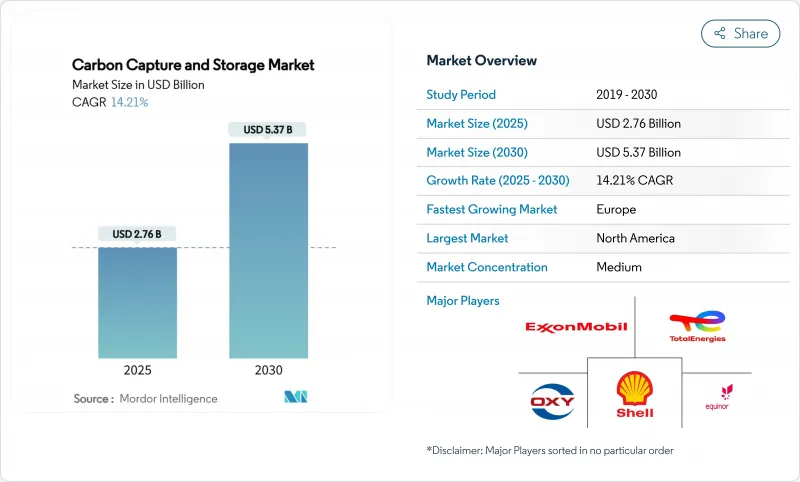
|
시장보고서
상품코드
1851788
세계의 탄소 포집 및 저장(CCS) 시장 : 점유율 분석, 산업 동향, 통계, 성장 예측(2025-2030년)Carbon Capture And Storage - Market Share Analysis, Industry Trends & Statistics, Growth Forecasts (2025 - 2030) |
||||||
세계의 탄소 포집 및 저장(CCS) 시장 규모는 2025년 27억 6,000만 달러로 추정되며, 예측 기간 중(2025-2030년) CAGR은 14.21%로 확대되어, 2030년까지 53억 7,000만 달러에 달할 것으로 예측됩니다.

규제 압력 증가, 포집 기술의 성숙화, 전용 삭감 솔루션 없이는 중공업이 넷 제로 의무를 완수할 수 없다는 인식이 이 확대를 지지하고 있습니다. 각국 정부는 배출량 규제 강화, 탄소 가격 제도 확대, 세제 우대 조치의 인상을 추진하고 있으며, CCS를 파일럿 스케일 실험에서 상업 전개로 시프트시키는 가격 신호를 창출하고 있습니다. 지지 정책과 기술 비용 저하의 수렴은 CCS를 미래 탄소 부채에 대한 헤지로 간주하는 석유 측정 및 산업 컨글로머릿의 민간 자본을 끌어들입니다. 그러나 시멘트, 철강, 화학, 정유소 등의 분야에서 CCS를 대체하는 실용적인 옵션은 거의 없으며 CCS는 과도 옵션이 아니라 구조적 요구 사항입니다.
세계 탄소 포집 및 저장(CCS) 시장 동향 및 통찰
CO2-EOR 프로젝트에 대한 새로운 수요
석유증진회수법(EOR)은 성숙한 저류층으로부터의 생산을 연장하면서 회수한 탄소를 수익화하는 두 가지 수익의 흐름을 창출하기 위해 다시 주목을 받고 있습니다. 석유 대기업은 고갈된 유전에 비료, 철강, 석유화학 배출사업자를 조합하여 초기 도입 단계에서 회수 거점을 이익을 낳는 자산으로 바꾸고 있습니다. 이 접근법은 투자 회수 기간을 단축하고 고정 고객을 확보하며 이미 광범위한 파이프라인 네트워크를 가진 지역에서의 인프라 정비를 가속화합니다. 또한 대용량 CO2를 처리하는 실용적인 경험을 제공하고, EOR 수요가 시간의 경과에 따라 감소해 가는 가운데, 순수한 저류 프로젝트에 대한 다리를 확립합니다. 증가하는 배럴로부터의 수익 가시성은 투자자가 분리 회수 플랜트 및 주입정에 필요한 고액의 초기 자본을 정당화하는 데 도움이 되며 독립 격리 서비스로의 전환을 원활하게 합니다.
탄소 가격 결정 및 배출권 거래 제도 확대
탄소 시장은 현재 캡 앤 트레이드의 틀을 넘어 국경 조정 및 섹터별 부과금을 포함할 때까지 확대되고 있으며, 규제 지역에 수출하는 제조자의 경제 계산을 바꾸고 있습니다. EU의 탄소 국경 조정 메커니즘은 수입된 배출 집약형 상품에 그림자 가격을 적용하고 해외 생산자에게 CCS 투자를 강제하고 시장 점유율을 잃을 위험을 피하고 있습니다. 캘리포니아는 캡 앤 트레이드를 2030년까지 연장하고 배출 프레임 할당을 엄격하게 함으로써 CCS를 기업의 사회적 책임이 아니라 컴플라이언스 비용 회피 수단으로 하고 있습니다. 자발적인 탄소 시장은 성숙하고 있으며, 추가성에 대한 의문은 남아 있으며, 검증된 저장 톤수에 대한 2차 수익화 경로는 여전히 형성되고 있습니다. 이러한 정책 수단은 모두 감축을 위한 바닥 가격을 높이고 감소 비용과 시장 인센티브 간의 경제적 격차를 줄이는 것입니다.
CCS 플랜트의 높은 CAPEX 및 OPEX
산업 규모의 설비에는 통상 5억-8억 달러의 선행 투자가 필요하고, 정책의 확실성이 낮은 경우, 펀드 파이낸싱은 곤란합니다. Carbon Clean의 CycloneCC와 같은 혁신적인 용매 시스템조차도 회수 비용을 1톤당 30달러까지 낮추고 있지만, 상업 규모의 규모 이점을 입증하기에는 이르지 못했습니다. 운전 비용은 베이스라인 플랜트의 효율을 15-30% 저하시키는 에너지 벌칙에 의해 더욱 큰 부담이 되어, 사업자는 전력을 추가 구입하거나 생산량의 저하를 받아들일 수밖에 없습니다. 개발도상국에서는 양허적 자금에 대한 접근이 여전히 제한되어 있어 배출감소의 요구가 커졌음에도 불구하고 도입이 지연되고 있습니다. 따라서 자본 집약도는 투자 회수 기간을 장기화하여 조기 도입자를 리스크를 흡수할 수 있는 대기업이나 국영 기업으로 좁힙니다.
부문 분석
2024년 탄소 포집 및 저장(CCS) 시장 점유율의 82.19%를 차지한 연소 전 포집은 정유소 및 화학 조합에서 이미 일반적인 스팀 메탄 개질 장치 및 바이오매스 가스화로와 연계되어 있습니다. 이 분야에는 수십년에 걸친 운전 데이터가 축적되어 있어, 그린필드 건설시에 설치했을 경우의 추가 비용이 낮다는 이점이 있습니다. 그러나 이 과정은 20-25%의 에너지 페널티를 부과하고 용매 재생은 여전히 자본 집약적입니다. 옥시연료 연소는 2030년까지 연평균 복합 성장률(CAGR) 18.51%의 성장이 예상되며 Brevik 시멘트 플랜트와 같은 대규모 배기 가스 분리 없이 공정 배기 가스를 회수하는 프로젝트에 밀려 나갑니다. 순수한 산소에서 연료를 연소시킴으로써, 배기 흐름은 거의 순수한 CO2가 되고, 다운스트림 압축이 단순화됩니다. 기술공급자는 리노베이션에 적합한 모듈식 산소 연료 유닛을 도입하여 공기분리의 경제성을 향상시켜 연소 후 대체연료에 대한 경쟁력을 강화하고 있습니다. 중공업이 최소의 효율 손실로 딥 컷을 추구함에 따라 옥시 연료 시장 점유율이 급속히 확대되고 탄소 포집 및 저장(CCS) 시장에서 오랫동안 주도해 온 예비 연소에 도전할 것으로 예측됩니다.
지역 분석
2024년 탄소회수 및 저장(CCS) 시장 점유율은 북미가 51.24%로 선두에 서서 직접 공기 포집에는 1톤당 85달러, 점광원 포집에는 60달러의 45Q세액 공제가 적용됩니다. 미국 멕시코만 해안에는 배출사업자, 파이프라인 회랑, 염수대 수층이 집중되어 있어 ExxonMobil이 제안하는 1,000억 달러의 Houston Ship Channel 네트워크와 같은 허브 구상이 가능합니다. 캐나다는 DAC 설비에 60%, 기타 회수 시스템에 50%의 투자 세액 공제를 적용하여 이 지역을 보완하고 Strathcona Resources와 캐나다 성장 기금(Canada Growth Fund)의 20억 달러 파트너십과 같은 합작 투자에 박차를 가하고 있습니다. 멕시코는 국경을 넘어 운송 파트너로 자리매김하고 고갈된 해안 유전에서의 공유 저장 솔루션을 모색하고 있습니다.
유럽은 2025-2030년 CAGR이 26.64%로 가장 빠를 것으로 예측되며, 혁신 기금, EU ETS, 2025년에 Northern Lights에서 CO2 주입을 시작한 노르웨이의 선구적인 롱쉽 프로젝트에 지지를 받고 있습니다. 독일의 CCS 법 초안은 육상 저류 금지를 철폐하고 북독해 해봉의 잠금을 해제하는 반면, 네덜란드는 Porthos 허브를 추진하고 영국은 HyNet과 Teeside 클러스터를 추진하고 있습니다. 국경을 넘어서는 수송 협정은 성숙해지고 있으며, 인프라를 공유하는 것으로, 소규모 산업 배출자에게는 단가가 내려갑니다. 탄소 가격, 국경 관세, 전용 공적 보조금의 조합이 민간 투자를 가속화하고 유럽은 일찍부터 움직이기 시작한 북미와의 차이를 확실히 줄입니다.
아시아태평양은 중국의 2060년 중립화 공약과 2025년 최초의 산소연료 시멘트 실증시험을 통해 지역 공정산업에 적합한 기술이 입증됨에 따라 장기적으로는 최대 상승 요인이 됩니다. 일본은 호주와 액화 CO2의 수송 루트를 공동 개발하여 중공업 지대와 보나파르트 해분의 해양 저류를 맺고 있습니다. 인도네시아는 풍부한 심해대 수층을 활용하여 2030년까지 15개 CCS 프로젝트를 목표로 하고 있습니다. 그러나 이 지역은 단편적인 규제와 적당한 자금에 대한 접근에 어려움을 겪고 있으며, 본격적인 이륙은 2030년 이후로 벗어날 수 있습니다.
기타 혜택:
- 엑셀 형식 시장 예측(ME) 시트
- 3개월의 애널리스트 서포트
목차
제1장 서론
- 조사의 전제조건과 시장의 정의
- 조사 범위
제2장 조사 방법
제3장 주요 요약
제4장 시장 상황
- 시장 개요
- 시장 성장 촉진요인
- CO2-EOR 프로젝트에 대한 새로운 수요
- 카본 프라이스 제도와 ETS 제도의 확대
- 국가의 넷 제로법 제도 강화
- 저탄소 합성 연료 프로젝트의 스케일 업
- 저장이 필요한 직접 공기 포집(DAC) 빌드 아웃
- 시장 성장 억제요인
- CCS 플랜트의 높은 CAPEX와 OPEX
- 보다 저렴한 재생에너지의 매력 증가
- 육상 CO2 파이프라인에 대한 여론의 반대
- 밸류체인 분석
- Porter's Five Forces
- 공급기업의 협상력
- 구매자의 협상력
- 신규 참가업체의 위협
- 대체품의 위협
- 경쟁도
제5장 시장 규모와 성장 예측
- 기술별
- 예비 연소 포집
- 연소 후 포집
- 옥시 연료 연소 포집
- 최종 사용자 업계별
- 석유 및 가스
- 석탄 및 바이오매스 발전소
- 철강
- 시멘트
- 화학제품
- 지역별
- 아시아태평양
- 중국
- 인도
- 일본
- 호주
- 한국
- 기타 아시아태평양
- 북미
- 미국
- 캐나다
- 멕시코
- 유럽
- 독일
- 영국
- 프랑스
- 노르웨이
- 네덜란드
- 러시아
- 기타 유럽
- 남미
- 브라질
- 아르헨티나
- 기타 남미
- 중동 및 아프리카
- 사우디아라비아
- 남아프리카
- 기타 중동 및 아프리카
- 아시아태평양
제6장 경쟁 구도
- 시장 집중도
- 전략적 동향
- 시장 점유율(%)/랭킹 분석
- 기업 프로파일
- Air Liquide
- Aker Solutions
- Baker Hughes
- Carbon Clean
- CF Industries Holdings, Inc.
- Climeworks
- Dakota Gasification Company
- ENEOS Xplora Inc.
- Equinor ASA
- Exxon Mobil Corporation
- Fluor Corporation
- General Electric Company
- Halliburton
- Honeywell International LLC
- Linde plc
- MITSUBISHI HEAVY INDUSTRIES, LTD.
- Occidental Petroleum Corporation
- Shell plc
- Siemens Energy
- SLB Capturi
- Svante Technologies Inc
- TotalEnergies
제7장 시장 기회와 장래의 전망
JHS 25.11.25The Carbon Capture And Storage Market size is estimated at USD 2.76 billion in 2025, and is expected to reach USD 5.37 billion by 2030, at a CAGR of 14.21% during the forecast period (2025-2030).

Rising regulatory pressure, maturing capture technologies, and the recognition that heavy industries cannot meet net-zero obligations without dedicated abatement solutions underpin this expansion. Governments are tightening emissions caps, expanding carbon-pricing schemes, and raising tax incentives, creating a price signal that has shifted CCS from pilot-scale experiments to commercial deployment. The convergence of supportive policy and technology cost decline also attracts private capital from oil majors and industrial conglomerates that see CCS as a hedge against future carbon liability. Competition from renewable power does temper the outlook, yet sectors such as cement, steel, chemicals, and refineries have few practical alternatives, making CCS a structural requirement rather than a transitional option.
Global Carbon Capture And Storage Market Trends and Insights
Emerging Demand for CO2-EOR Projects
Enhanced oil recovery is regaining prominence because it creates dual revenue streams-monetizing captured carbon while extending production from mature reservoirs. Oil majors are pairing fertiliser, steel, and petrochemical emitters with depleted fields, turning capture hubs into profit-generating assets during the early adoption stage. The approach lowers payback periods, secures anchor customers, and accelerates infrastructure build-out in regions that already possess extensive pipeline networks. It also provides practical experience in handling large CO2 volumes, establishing a bridge to pure storage projects as EOR demand tails off over time. Revenue visibility from incremental barrels helps investors justify the high upfront capital required for capture plants and injection wells, smoothing the transition toward stand-alone sequestration services.
Expansion of Carbon-Pricing and ETS Schemes
Carbon markets now extend beyond cap-and-trade to include border adjustments and sector-specific levies, changing the economic calculus for manufacturers that export into regulated regions. The EU's Carbon Border Adjustment Mechanism applies a shadow price to imported emissions-intensive goods, forcing foreign producers to invest in CCS or risk losing market share. California extended its cap-and-trade through 2030 and tightened allowance allocations, making CCS a compliance cost-avoidance tool rather than a corporate social responsibility add-on. Voluntary carbon markets are maturing, and though questions around additionality persist, they still create secondary monetization routes for verified storage tonnes. Each of these policy levers lifts the floor price for abatement, narrowing the economic gap between capture costs and market incentives.
High CAPEX and OPEX of CCS Plants
Industrial-scale facilities routinely require USD 500 million-800 million in upfront investment, making equity financing challenging where policy certainty is weak. Even innovative solvent systems such as Carbon Clean's CycloneCC, which lowers capture cost to USD 30 per tonne, have yet to demonstrate economies of scale at commercial rates . Operating cost is further burdened by energy penalties that trim baseline plant efficiency 15-30%, forcing operators either to buy additional electricity or accept lower output. Access to concessional finance remains limited in developing economies, delaying uptake despite substantial emissions reduction needs. Capital intensity therefore prolongs payback periods and narrows the pool of early adopters to large corporations or state-owned enterprises capable of absorbing risk.
Other drivers and restraints analyzed in the detailed report include:
- Stricter National Net-Zero Legislation
- Scale-Up of Low-Carbon Synthetic-Fuel Projects
- Growing Attractiveness of Cheaper Renewables
For complete list of drivers and restraints, kindly check the Table Of Contents.
Segment Analysis
Pre-combustion capture accounted for 82.19% of carbon capture and storage market share in 2024 because it dovetails with steam-methane reformers and biomass gasifiers already common in refineries and chemical complexes . The segment benefits from decades of operational data and lower incremental cost when installed during greenfield builds. However, the process imposes a 20-25% energy penalty, and solvent regeneration remains capital intensive. Oxy-fuel combustion is projected to grow 18.51% CAGR to 2030, propelled by projects such as the Brevik cement plant that capture process emissions without extensive flue-gas separation. By burning fuel in pure oxygen, the exhaust stream is nearly pure CO2, simplifying downstream compression. Technology providers are introducing modular oxy-fuel units suited for retrofit, and improved air-separation economics reinforce competitiveness against post-combustion alternatives. As heavy industries seek deep cuts with minimal efficiency loss, oxy-fuel's market share is expected to expand quickly, challenging pre-combustion's long-held lead in the carbon capture and storage market.
The Carbon Capture and Storage Market Report is Segmented by Technology (Pre-Combustion Capture, Post-Combustion Capture, and Oxy-Fuel Combustion Capture), End-User Industry (Oil and Gas, Coal and Biomass Power Plant, Iron and Steel, Cement, and Chemical), and Geography (Asia-Pacific, North America, Europe, South America, and Middle-East and Africa). The Market Forecasts are Provided in Terms of Value (USD).
Geography Analysis
North America led with 51.24% carbon capture and storage market share in 2024, supported by generous 45Q tax credits that provide USD 85 per tonne for direct air capture and USD 60 for point-source capture. The U.S. Gulf Coast concentrates emitters, pipeline corridors, and saline aquifers, enabling hub concepts like ExxonMobil's proposed USD 100 billion Houston Ship Channel network. Canada complements the region with an investment tax credit of 60% for DAC equipment and 50% for other capture systems, spurring joint ventures such as Strathcona Resources and Canada Growth Fund's USD 2 billion partnership. Mexico positions itself as a cross-border transport partner, exploring shared storage solutions in depleted offshore fields.
Europe is projected to post the fastest CAGR at 26.64% between 2025-2030, underpinned by the Innovation Fund, the EU ETS, and Norway's pioneering Longship project, which began CO2 injection at Northern Lights in 2025. Germany's draft CCS law removes the onshore storage ban and unlocks the North German Basin, while the Netherlands advances the Porthos hub and the UK pushes HyNet and Teesside clusters. Cross-border transport agreements are maturing, and shared infrastructure lowers unit costs for smaller industrial emitters. The combination of carbon pricing, border tariffs, and dedicated public grants accelerates private investment, ensuring that Europe closes the gap with early-moving North America.
Asia-Pacific represents the largest long-term upside, driven by China's 2060 neutrality pledge and the first oxy-fuel cement demonstration in 2025, which validated technology fit for regional process industries. Japan is co-developing shipping routes with Australia for liquefied CO2, linking heavy industrial zones with offshore storage in the Bonaparte Basin . Indonesia targets 15 CCS projects by 2030, leveraging abundant deep-saline aquifers, while South Korea's Green New Deal earmarks CCS expenditure across steel and petrochemicals. The region, however, grapples with fragmented regulations and access to affordable finance, factors that may delay full-scale take-off until post-2030.
- Air Liquide
- Aker Solutions
- Baker Hughes
- Carbon Clean
- CF Industries Holdings, Inc.
- Climeworks
- Dakota Gasification Company
- ENEOS Xplora Inc.
- Equinor ASA
- Exxon Mobil Corporation
- Fluor Corporation
- General Electric Company
- Halliburton
- Honeywell International LLC
- Linde plc
- MITSUBISHI HEAVY INDUSTRIES, LTD.
- Occidental Petroleum Corporation
- Shell plc
- Siemens Energy
- SLB Capturi
- Svante Technologies Inc
- TotalEnergies
Additional Benefits:
- The market estimate (ME) sheet in Excel format
- 3 months of analyst support
TABLE OF CONTENTS
1 Introduction
- 1.1 Study Assumptions and Market Definition
- 1.2 Scope of the Study
2 Research Methodology
3 Executive Summary
4 Market Landscape
- 4.1 Market Overview
- 4.2 Market Drivers
- 4.2.1 Emerging Demand for CO2-EOR Projects
- 4.2.2 Expansion of Carbon-Pricing and ETS Schemes
- 4.2.3 Stricter National Net-Zero Legislation
- 4.2.4 Scale-Up of Low-Carbon Synthetic-Fuel Projects
- 4.2.5 Direct-Air-Capture (DAC) Build-Outs Needing Storage
- 4.3 Market Restraints
- 4.3.1 High CAPEX And OPEX Of CCS Plants
- 4.3.2 Growing Attractiveness of Cheaper Renewables
- 4.3.3 Public Opposition to On-Shore CO2 Pipelines
- 4.4 Value Chain Analysis
- 4.5 Porter's Five Forces
- 4.5.1 Bargaining Power of Suppliers
- 4.5.2 Bargaining Power of Buyers
- 4.5.3 Threat of New Entrants
- 4.5.4 Threat of Substitutes
- 4.5.5 Degree of Competition
5 Market Size and Growth Forecasts (Value)
- 5.1 By Technology
- 5.1.1 Pre-combustion Capture
- 5.1.2 Post-combustion Capture
- 5.1.3 Oxy-fuel Combustion Capture
- 5.2 By End-user Industry
- 5.2.1 Oil and Gas
- 5.2.2 Coal and Biomass Power Plant
- 5.2.3 Iron and Steel
- 5.2.4 Cement
- 5.2.5 Chemical
- 5.3 By Geography
- 5.3.1 Asia-Pacific
- 5.3.1.1 China
- 5.3.1.2 India
- 5.3.1.3 Japan
- 5.3.1.4 Australia
- 5.3.1.5 South Korea
- 5.3.1.6 Rest of Asia-Pacific
- 5.3.2 North America
- 5.3.2.1 United States
- 5.3.2.2 Canada
- 5.3.2.3 Mexico
- 5.3.3 Europe
- 5.3.3.1 Germany
- 5.3.3.2 United Kingdom
- 5.3.3.3 France
- 5.3.3.4 Norway
- 5.3.3.5 Netherlands
- 5.3.3.6 Russia
- 5.3.3.7 Rest of Europe
- 5.3.4 South America
- 5.3.4.1 Brazil
- 5.3.4.2 Argentina
- 5.3.4.3 Rest of South America
- 5.3.5 Middle-East and Africa
- 5.3.5.1 Saudi Arabia
- 5.3.5.2 South Africa
- 5.3.5.3 Rest of Middle-East and Africa
- 5.3.1 Asia-Pacific
6 Competitive Landscape
- 6.1 Market Concentration
- 6.2 Strategic Moves
- 6.3 Market Share(%)/Ranking Analysis
- 6.4 Company Profiles (includes Global level Overview, Market level overview, Core Segments, Financials as available, Strategic Information, Market Rank/Share for key companies, Products and Services, and Recent Developments)
- 6.4.1 Air Liquide
- 6.4.2 Aker Solutions
- 6.4.3 Baker Hughes
- 6.4.4 Carbon Clean
- 6.4.5 CF Industries Holdings, Inc.
- 6.4.6 Climeworks
- 6.4.7 Dakota Gasification Company
- 6.4.8 ENEOS Xplora Inc.
- 6.4.9 Equinor ASA
- 6.4.10 Exxon Mobil Corporation
- 6.4.11 Fluor Corporation
- 6.4.12 General Electric Company
- 6.4.13 Halliburton
- 6.4.14 Honeywell International LLC
- 6.4.15 Linde plc
- 6.4.16 MITSUBISHI HEAVY INDUSTRIES, LTD.
- 6.4.17 Occidental Petroleum Corporation
- 6.4.18 Shell plc
- 6.4.19 Siemens Energy
- 6.4.20 SLB Capturi
- 6.4.21 Svante Technologies Inc
- 6.4.22 TotalEnergies
7 Market Opportunities and Future Outlook
- 7.1 White-space and unmet-need assessment



















